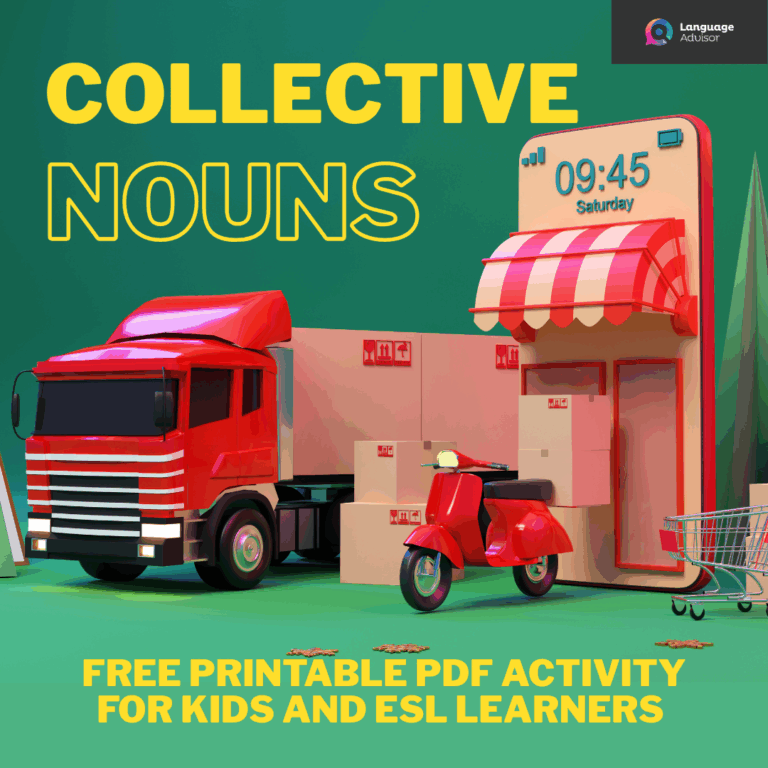Category Crunch Game: 11 Exciting ESL Games for Word Category Revision. Free Activities to reviese categories of words.
Category Crunch Game

Are you ready to take your ESL classroom on a thrilling journey through the world of word categories? Welcome to our blog post, where we’re diving deep into 11 engaging ESL games designed to revise categories of words! Whether you’re looking to reinforce vocabulary, spark creativity, or encourage collaboration, these interactive activities are sure to captivate your students’ attention and elevate their language skills. Join us as we explore each game, providing insights into how they can transform your classroom into a dynamic hub of learning and exploration.
Let’s embark on an adventure to make word category revision both fun and effective for your ESL students!
Category Crunch Game

Balloon Volleyball
This energetic category game helps students to revise categories of words. This game is exactly like volleyball, but instead of a ball, a balloon is used.
- Age/Level: Young learners
- Time: 10-15 minutes
- Players: 2 teams
- Preparation: A balloon
- Aim: To keep a balloon airborne while saying words from a category.
Procedure
Put the students into two teams. If you have a large class, make more teamsand create a volleyball tournament. Start the game by shouting out a category, e.g. adverbs.
Every time the balloon is hit, either to another player or over to the other team, the student hitting the balloon must say a word from the category. If the balloon hits the floor, a word is not said, or a word is repeated the opposing team wins a point. Play for five minutes and then change sides or teams accordingly.

Board Races
Board races are a good way for students to brainstorm their vocabulary knowledge. This enjoyable category game helps students focus on the vocabulary for the subject or topic you are teaching.
- Age/Level: Young learners
- Time: 15 minutes
- Players: 3 teams
- Preparation: None
- Aim: To write words connected to a category
Procedure
Split the class into three teams. Draw three columns on the board. Have each team line up in front of a column and give the first player in each team a marker or chalk. Write a category on the board and set a target number of 10 to 20 words depending on the level of the class. The first player in each team runs to the board, writes a word connected to the category, gives the marker/chalk to the next student, and goes to the back of the line. Then the second player runs to the board and so on.
The first team to reach the target number and have suitable words and correct spelling wins a point. Play multiple rounds and then add up the scores.

Category Battleship
This is a classroom version of the battleships game. Before class, make one copy of the battleships grid for each student.
- Age/Level: Young learners
- Time: 20 minutes
- Players: Pairs
- Preparation: Copy the worksheet
- Aim: To find all the category words on a partner’s battleship grid
Procedure
Divide the students into two groups (A and B) and give each student a copy of the worksheet. Give Group A a category and Group B another category.
Working with the people in their team, the students come up with seven words belonging to their category. Each word is a battleship. The students enter the words on the grid entitled ‘My Ships’, horizontally, vertically or diagonally, one letter per square. Next, students pair up with someone from the other group.
The students take turns in trying to sink each other’s battleships.
They do this by saying a grid number, e.g. C4. If there is a letter in that square, the other student reveals it. If the square is blank, the student says “Miss.” At any point a student may guess the complete word, but only one guess is allowed per turn.
The first student to sink all of their partner’s battleships (i.e. find all the words) wins. You can vary the size of the grid, number of words, length of words, rules about positioning, number of shots per turn, etc.

In the Circle
Here is a challenging category game that can be adapted to any teaching topic or level. You will need a ball or similar object before you start the game.
- Age/Level: Any
- Time: 15 minutes
- Players: Individual
- Preparation: A ball
- Aim: To name six things specified by another student in a limited time
Procedure
Start the game by choosing seven students to play first. Arrange six chairs in a circle and choose one of the students to stand outside of the circle.
The other six students sit on the chairs. The student outside the circle chooses which player should have the ball and states what the person holding the ball has to name six of. For example, you have just finished teaching sports.
The student might say, “Name six team sports.” The player with the ball then passes it to the student sitting next to them, and it goes around the circle.
The player must name the six things specified by the student standing outside the circle before the ball gets back to them. If the player cannot name six things by the time the ball reaches them, they exit the game and have to go and sit down.
The student standing outside the circle then takes the vacant seat. A new student can then play and starts by standing outside of the circle.
Alternatively, you could play this game with different numbers of students and ask them to name more or less things, depending on the number of students. The loser has to stand outside the circle.

Monkey in the Middle
Enjoy playing this dynamic category game with your students.
- Age/Level: Young learners
- Time: 10 minutes
- Players: Individual
- Preparation: A ball
- Aim: To say words within a category
Procedure
Start by having the students make a large circle. Select one student to be the monkey. The monkey stands in the middle of the circle. Give the students a category, e.g. cities.
The students in the circle throw the ball around the circle so that the monkey can’t get it. Every time a student throws the ball, they say a word from the category, e.g. London.
If a student can’t think of a word, they become the monkey. If the monkey gets the ball, the thrower becomes the new monkey. Change the category whenever there is a new monkey. Play until time is up.

One by One
In this category game, students guess words belonging to a category as letters are gradually added to the word.
- Age/Level: Any
- Time: 20 minutes
- Players: 2 Teams
- Preparation: 8 category words
- Aim: To guess words belonging to a category
Procedure
Before you play, prepare a list of eight words belonging to a category, e.g. if your category is animals, you might write: 1. monkey, 2. tiger, 3. elephant, 4. hippopotamus, 5. cat, 6. deer, 7. leopard, 8. giraffe.
Divide the class into two teams (A and B). Write numbers 1 to 8 on the board.
Tell the students what the words have in common, e.g. they are all animals. Ask Team A to choose a number. Write the first letter of the word next to the number. Team A can try to guess the word or pass. If they guess correctly, they get one point and the next turn. If they guess incorrectly, play passes to Team B.
If only one letter is left and a team has failed to guess the word, just add the remaining letter. Play a few rounds to see which team is the overall winner.

Scattegories
To think of words in a category that begins with a certain letter
- Age/Level: Any
- Time: 20 minutes
- Players: Any
- Preparation: A list of categories
- Aim: To think of words in a category that begins with a certain letter
Procedure
Start the game by writing ten categories on the board. This game can be played individually, in pairs or small teams.
Tell the students that they are going to play a game where they think of words in a category beginning with a certain letter.
Explain that in order to win points the students must come up with words that no one else has thought of.
Draw the students’ attention to the categories on the board and then reveal the initial letter and start timing. Allow about two to three minutes for each round. Students must try to think of one answer for each category.
When the time limit has been reached, students read their answers aloud. They score one point for each unique word that no one else has written. After each round, change the initial letter. The winner is the student/team with the most points at the end.

Seek and Destroy
This competitive ESL game helps students to match words to categories.
- Age/Level: Any
- Time: 20 minutes
- Players: 2 teams
- Preparation: Create ten categories with three words in each category
- Aim: To identify words from a category
Procedure
Begin the category game by covering the board with category words. There should be ten categories of words with three words in each category. Only write the words and not the categories on the board and make sure the words are all mixed up.
Divide the class into two teams. Have each team line up at the back of the room. Make sure that the students have a clear run to the board.
Give the first student in each team a marker or chalk. Call out a category, e.g. animals. The students at the front of each line race each other to the board and circle one of the words in that category.
The first student to correctly circle a word wins a point for their team. Continue with the next two students and so on. Keep on calling and awarding points until all the words have been circled. The team with the highest number of points wins. You can make the game last longer or shorter just by using more or less categories.

Stop
In this entertaining category game, students write down category words beginning with a certain letter. Students must try to think of uncommon words in order to win more points for their team.
- Age/Level: Any
- Time: 25 minutes
- Players: 4 teams
- Preparation: None
- Aim: To write less common category words beginning with a particular letter
Procedure
Divide the class into four teams. Write five to ten categories on the board.
Give each team a piece of paper and ask them to copy down the categories. Next, choose two students and ask them to come to the front of the class. Tell one student to start saying the letters of the alphabet. Tell the other student to shout Stop! on any letter they choose.
Once a letter has been chosen, tell the teams to write down one word belonging to each category beginning with that letter. The first team to write a word for every category shouts Stop! and the otherteams stop writing. The teams then give their paper to another team for marking. Each team in turn reads out the words on their paper.
The scoring is as follows: The words that are not repeated by any team are worth 100 points. The words repeated by two teams are worth 50 points.
The words repeated by three or more teams are worth 25 points. Each team adds up the points and the teacher writes the scores on the board for that round. Then, another round is played and so on. At the end of the game, the team with the highest score wins.

Stop the Music Game
This lively vocabulary game is ideal for reviewing categories of words.
- Age/Level: Any
- Time: 20 minutes
- Players: Small teams
- Preparation: Dance music
- Aim: To write ten category words beginning with a certain letter
Procedure
On the board, write ten categories and number them one to ten, e.g. 1. sports, 2. verbs, 3. animals, etc. In the centre of the board, draw a square.
Split the class into small teams and give each team a number. Each team should have a piece of paper and a pen. Tell each team to choose one student to do the writing and to write 1 to 10 on their paper.
Bring the students’ attention to the ten categories on the board. In the square on the board, write a letter, e.g. B. Ask the class to think of a word beginning with that letter for each category and write their answers on the board, e.g. badminton, buy, bird, etc.
Next, explain that you will write a new letter in the square, but this time the teams must write down their ten answers on their paper. Tell the teams while they are writing their answers, you will play some music (dance music works best).
Explain that the first team to finish must shout, “Stop the music!” The music is stopped and if the team has ten correct answers, they win the round and ten points. Then a new round starts with a different letter.
How the students show you their answers is up to you. Asking them to shout out their answers is the quickest way, but you might ask them to write the answers on the board or just show you the answers.
Example:


Stick Men
This is a fun category game for students of English.
- Age/Level: Any
- Time: 15 minutes
- Players: Any
- Preparation: None
- Aim: To come up with words that relate to a category
Procedure
This game can be played individually, in pairs or small teams, depending on the size of your class. Give each team (student or pair) a number and write the numbers on the board. Next to each number draw three stick men.
The stick men represent each team’s number of lives.
Now, give the teams a category, e.g. animals.
The teams must come up with words that relate to that category.
Each team in turn says one word relating to the category and this continues around the class.
Once a word has been said, it cannot be repeated. If a word is repeated, the team who said the word loses a life. Also, if a team takes too long to come up with a word or can’t think of a word, they lose a life. When a team loses all three lives, they are out of the game.
Continue with the category until only one team is left. That team is the winner.

List of Categories

Category Crunch Game. Here are some other English ESL vocabulary resources












